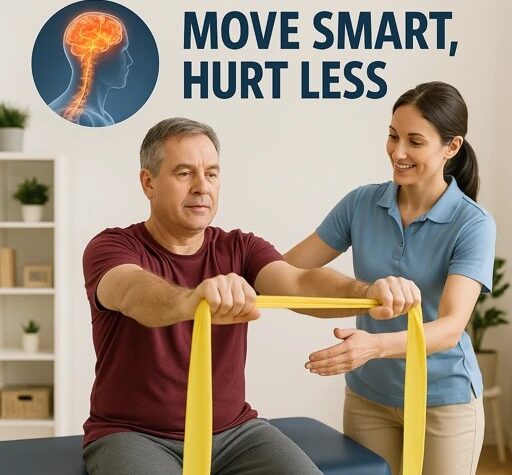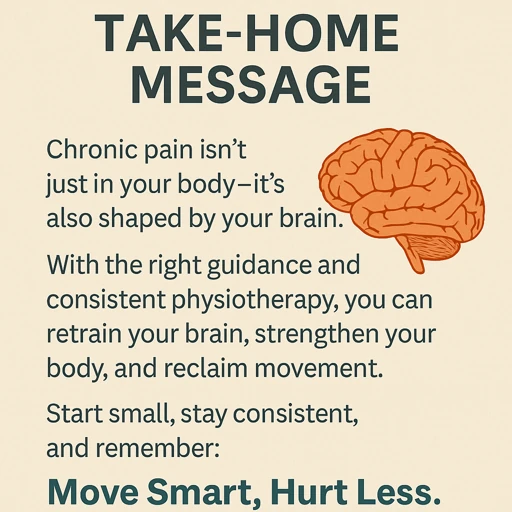Physiotherapy for Chronic Pain – Everything You Wanted to Know

By Dr. Pavandeep | Musculoskeletal Physiotherapist
Chronic Pain – The Unwanted Guest That Never Leaves
Imagine stubbing your toe on the corner of a table. Ouch! Now imagine that pain deciding it quite likes you—and stays for 3 months or more, uninvited, making itself at home like a bad in-law who won’t leave. That’s chronic pain for you.
Chronic pain isn’t just a lingering ache—it’s a complex condition that affects over 20% of the adult population, often showing up with no obvious reason, no apology, and unfortunately, no expiration date. It doesn’t discriminate—it can tag along with arthritis, back pain, nerve injuries, or sometimes appear like a mystery guest at a party (one you didn’t throw).
Physiologically, it goes beyond the original injury. The nervous system becomes overprotective, like a car alarm that won’t stop going off even when there’s no threat. Your brain and spinal cord get stuck in “red alert” mode, making everything feel more painful than it should. This is called central sensitisation—basically, your pain system becomes a bit of a drama queen.
But the impact isn’t just physical:
- It steals sleep like a toddler in a sleep regression.
- It disrupts work and relationships, turning simple daily tasks into uphill battles.
- It brings along emotional baggage—like anxiety, depression, and frustration—without asking if you’ve got room for all that.
And let’s not forget the economic toll—millions lost in productivity, medical bills, and pain creams that promise miracles but smell like your grandfather’s sock drawer.
Yet, there’s hope. Thanks to advances in neuroscience, we now understand that chronic pain isn’t “all in your head”—but it is influenced by how your brain processes it. This opens the door to holistic management through physiotherapy, pain education, graded movement exposure, and cognitive strategies.
So yes, chronic pain might be a persistent, annoying guest—but with the right approach, you can show it the door (or at least make it stay quiet in the corner while you get on with your life).
Here are some clear answers to the questions we hear most often—let’s make things easier for you.
1. What exactly is chronic pain?
Chronic pain is pain that lasts longer than 3 months, often continuing even after the body has physically healed. It’s not just about damaged tissues — it’s about how your nervous system becomes sensitized, staying on high alert.
2. Why does my pain remain even if my scan is normal?
Great question — and very common. Scans show structure, not sensation. In chronic pain, your brain and spinal cord can “learn pain” through a process called central sensitisation. That means your system can send pain signals even without damage.
3. Can physiotherapy help even if I’ve had pain for years?
Absolutely! Physiotherapy doesn’t just treat joints and muscles. It also works on your nervous system, posture, movement patterns, and mindset — all of which influence pain. Techniques like graded movement, pain education, breathing training, and CBT-informed care are game changers.
4. What is Pain Neuroscience Education (PNE)?
PNE helps you understand that pain is a protector, not always a problem. You’ll learn how the brain processes pain, and why feeling pain doesn’t mean something is damaged. Once fear reduces, movement becomes safer and less painful.
5. Is manual therapy still useful in chronic pain?
Yes — but not because it ‘fixes’ things. Instead, manual therapy helps by calming the nervous system, reducing pain short-term, and giving you the confidence to start moving again. It’s like giving the system a “reset” to encourage active rehab.
6. I’m scared of moving – won’t it make things worse?
That’s a very valid fear. Physiotherapists use graded exposure therapy, where you slowly and safely return to movements you’ve avoided. This helps re-train your brain to trust your body again, building confidence without triggering flare-ups.
7. What is Cognitive Functional Therapy (CFT)?
CFT is a personalized, empowering approach where we help you change pain-related beliefs and habits, coach you through movements, and build strategies to deal with stress, sleep, and life demands that amplify pain.
8. Is chronic pain all in the mind?
No — the pain you feel is very real. But your brain, beliefs, and emotions play a huge role in how intense it feels. By working on these factors alongside physical rehab, you can change the experience of pain and get your life back.
9. What if I’ve already tried exercise and it didn’t work?
Many people do exercise the wrong way for chronic pain — too fast, too intense, or without addressing the fear and stress around it. With graded, personalised physiotherapy, your program is tailored to your current abilities, nervous system sensitivity, and recovery goals.
10. How do I start?
Start by seeing a physiotherapist trained in chronic pain rehabilitation. They’ll assess your pain story, movement, beliefs, and goals — then work with you to build a roadmap that fits your life. You are not broken. You can heal.

– Pain that lasts isn’t always about injury — it’s about how your system processes danger.
– Movement, when done right, is medicine for your nervous system.
– Your physiotherapist is your coach, guide, and cheerleader in this recovery journey.
PAIN is plastic. And so is RECOVERY.”
Follow us for more pain science made simple—backed by evidence, delivered with empathy.
